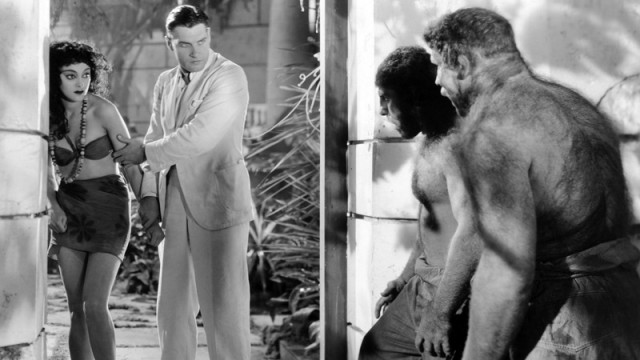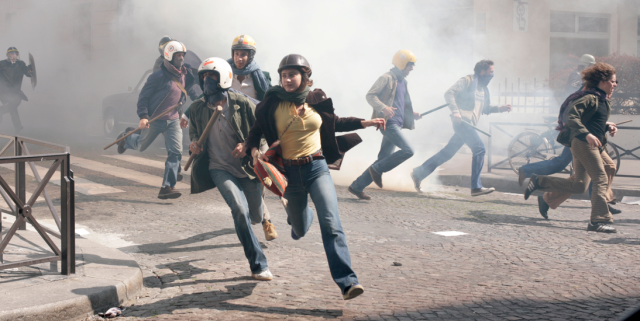“Do you feel like any of this is wrong? Do any of you feel like any of this is wrong? Coz I feel like some of this is wrong,” Australian musician and activist Xavier Rudd declares on “Comfortable in My Skin,” one of thirteen eco-friendly tracks on his seventh studio album, Spirit Bird (SideOneDummy, June 2012). A one-man band who fights for the environment, indigenous cultures, animal rights, and other causes, Rudd again plays a multitude of instruments on the new record, including numerous guitars, keyboards, harmonica, drums, a stomp box, and the yidaki, (didgeridoo). In addition, several songs feature bird and whale samples; one of Rudd’s current causes, and whose call can be heard on Spirit Bird, is the endangered black cockatoo. Rudd is currently participating in an online auction sponsored by the Kaarakin Black Cockatoo Rehabilitation Centre, where he recently visited. He has donated a specially commissioned, signed Tjukurtjarra Didgeridoo on which he has written, “One love / One mob / For country / Arms up / Thank you, Kaarakin!” (The current bid is $2,200; the auction continues through October 31.) Rudd’s world music sound mixes elements of folk, pop, dance, and reggae with African and aboriginal rhythms that often border on New Age before picking up speed, especially on the epic, mostly instrumental ten-minute “Full Circle.” The album ends with Rudd pleading, “Please patience please patience please / I’m creating a dream.” You can join Rudd’s ever-growing movement on October 28, when he plays Irving Plaza with Yeshe.
Yearly Archives: 2012
ISLAND OF LOST SOULS
ISLAND OF LOST SOULS (Erle C. Kenton, 1932)
Nitehawk Cinema
136 Metropolitan Ave.
Saturday, October 27, and Sunday, October 28, 12:15 pm
718-384-3980
www.nitehawkcinema.com
 “Are we not men?” declares the Sayer of the Law (Bela Lugosi) in Erle C. Kenton’s 1932 horror classic, Island of Lost Souls. (Yes, the phrase was eventually coopted by Devo.) After surviving a shipwreck, Edward Parker (Richard Arlen) soon finds himself on a very strange island where it appears that a madman named Dr. Moreau (Charles Laughton) is experimenting on living beings in rather inhumane ways. While his fiancée, Ruth Thomas (Leila Hyams), is trying to find him, Parker starts hanging around with Lota (Kathleen Burke), but there’s more to her than meets the eye. As Parker continues to poke around, he learns a little too much about what’s going on, meaning it just might be the House of Pain for him if he doesn’t watch out. Island of Lost Souls is a creepy pre-Code horror flick that holds up surprisingly well, with odd twists and turns that include more than just hints of torture, S&M, and bestiality. Laughton seems to be having a blast, pulling out his whip to tame his creations, enjoying it all way too much. It was quite a year for the British-born American actor, who also played Nero in Cecil B. DeMille’s The Sign of the Cross and the title character (winning an Oscar) in Alexander Korda’s The Private Life of Henry VIII in 1932. Island of Lost Souls is based on the H. G. Wells novel The Island of Dr. Moreau, which was also filmed in 1977 by Don Taylor, with Burt Lancaster as the doctor, Michael York as the curious wayward traveler, and Richard Basehart as the Sayer of the Law, and more famously by John Frankenheimer in 1997, with Marlon Brando as Moreau, David Thewliss as the shipwreck survivor, and Ron Perlman as the Sayer of the Law, often considered one of the worst films ever made.
“Are we not men?” declares the Sayer of the Law (Bela Lugosi) in Erle C. Kenton’s 1932 horror classic, Island of Lost Souls. (Yes, the phrase was eventually coopted by Devo.) After surviving a shipwreck, Edward Parker (Richard Arlen) soon finds himself on a very strange island where it appears that a madman named Dr. Moreau (Charles Laughton) is experimenting on living beings in rather inhumane ways. While his fiancée, Ruth Thomas (Leila Hyams), is trying to find him, Parker starts hanging around with Lota (Kathleen Burke), but there’s more to her than meets the eye. As Parker continues to poke around, he learns a little too much about what’s going on, meaning it just might be the House of Pain for him if he doesn’t watch out. Island of Lost Souls is a creepy pre-Code horror flick that holds up surprisingly well, with odd twists and turns that include more than just hints of torture, S&M, and bestiality. Laughton seems to be having a blast, pulling out his whip to tame his creations, enjoying it all way too much. It was quite a year for the British-born American actor, who also played Nero in Cecil B. DeMille’s The Sign of the Cross and the title character (winning an Oscar) in Alexander Korda’s The Private Life of Henry VIII in 1932. Island of Lost Souls is based on the H. G. Wells novel The Island of Dr. Moreau, which was also filmed in 1977 by Don Taylor, with Burt Lancaster as the doctor, Michael York as the curious wayward traveler, and Richard Basehart as the Sayer of the Law, and more famously by John Frankenheimer in 1997, with Marlon Brando as Moreau, David Thewliss as the shipwreck survivor, and Ron Perlman as the Sayer of the Law, often considered one of the worst films ever made.
TWI-NY TALK: JOHN BALDESSARI
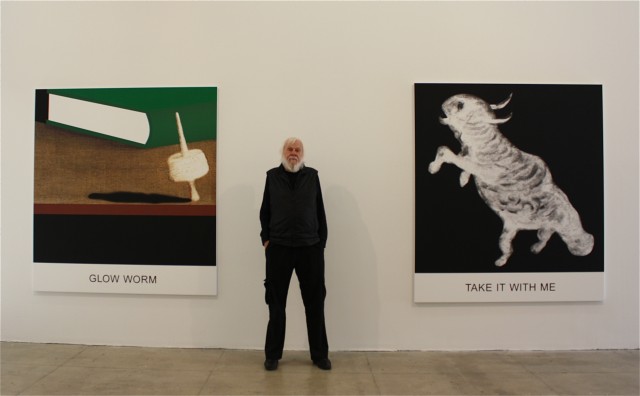
John Baldessari is once again screwing with people’s minds in latest solo show at Marian Goodman (photo by twi-ny/mdr)
JOHN BALDESSARI: DOUBLE PLAY
Marian Goodman Gallery
24 West 57th St. between Fifth & Sixth Aves.
Tuesday – Saturday through November 21, free, 10:00 am – 6:00 pm
212-977-7160
www.mariangoodman.com
As John Baldessari and I sat down in the conference room at Marian Goodman Gallery to discuss his latest solo show there, “Double Play,” I realized that the cord on my old-fashioned tape recorder couldn’t reach the nearest outlet. Sensing the dilemma, the six-foot-seven, eighty-one-year-old artistic genius said, “Too bad you can’t use that,” and pointed behind me. When I turned around, I saw his 1997 Goya Series canvas “It Serves You Right,” a black-and-white image of a plug beneath an empty four-pronged outlet. Fortunately, the good people at the gallery were kind enough to find a long, orange extension cord so we could get down to business.
“I’ve got to say, I don’t like being labeled a California artist, or a Los Angeles artist, or a Conceptual artist,” Baldessari later pointed out. “I just like it to be artist.” For more than fifty years, Baldessari has been creating provocative paintings, video, and sculpture that combine text and language with art-historical and pop-culture imagery. He’s placed colorful circles over subjects’ faces and filmed himself posing in front of a camera and declaring over and over again, “I am making art.” He’s experienced a kind of renaissance lately, with a well-received traveling retrospective, “Pure Beauty,” that came to the Met in the fall of 2010, and two recent promotional videos that have gone viral, “A Brief History of John Baldessari,” a wildly funny biography narrated by musician Tom Waits, and a Pacific Standard Time short in which Baldessari’s giant head chases actor Jason Schwartzman through the streets of L.A.
For “Double Play,” Baldessari made inkjet prints of enlarged sections of works by such artists as Paul Gauguin, Honoré Daumier, Otto Dix, and Édouard Manet, painted over them, then named them after song titles by Waits, Kander and Ebb, Portastic, Johnny Mercer, and others. “Eggs and Sausage” reimagines Gustave Courbet’s “Portrait of Paul Ansout,” combining it with block type of the title of a 1975 song by Waits. For “Animal Crackers in My Soup,” Baldessari focuses on two of the women in Félix Valloton’s “Three Women and a Young Girl Frolicking in the Water,” making it look like they’re kissing, and adding the title of the song made famous by Shirley Temple.
A careful thinker who punctuates many of his statements with an infectious laugh, Baldessari is a gentle, unassuming man whose striking white hair and beard and mustache stand out in stark contrast to his black clothing. He spoke honestly and openly about art and life, encouraging more questions even as our time together was coming to a close.
twi-ny: You’ve spent part of the last few years looking back at your long career, with the “Pure Beauty” retrospective and a continuing series of Catalogue Raisonné volumes. Do you think that has directly influenced your current work?
John Baldessari: Well, I think it’s always valuable to look at the arc of your career, of what you’ve done and what you might do, and retrospectives can provide that. So do Catalogue Raisonnés. It all helps, to see where you’ve been and where you might go.
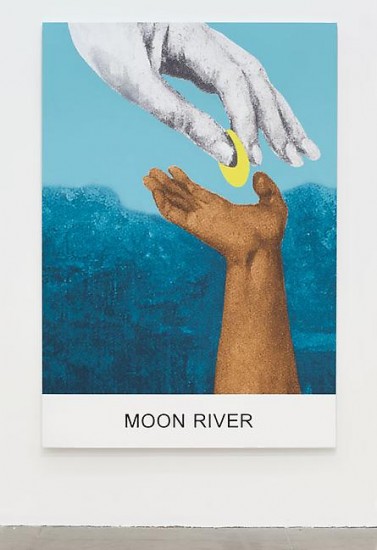
John Baldessari, “Double Play: Moon River,” varnished inkjet print on canvas with acrylic and oil paint, 2012 (photo courtesy Marian Goodman Gallery)
twi-ny: In putting together the two new series, you compare yourself to Dr. Frankenstein. How do you go about choosing the different elements?
John Baldessari: The underlying idea is that I always think of language and imagery as of equal value. So very often in my work I have both — sometimes not, but right now I do — but I consider the song title as valuable as the image. What I’m trying to do is not make it easy for people to make the connection between the image and the language, make it a little difficult. Which is impossible, because people want to do that, they want to hook up things together. A few of them, I just look the other direction, like the dog and “Feelings” — that’s like a Hallmark card. But on the other ones, I think, “Moon River,” I mean, come on. But a lot of them, I found out, I went through the list of song titles trying to hit ones that wouldn’t provide a ready connection. And as a result, I have five or more that are Tom Waits; he’s really good at that.
twi-ny: In “Feelings,” for example, you have a dog, but “Walking the Dog” isn’t with the picture of a dog, which confuses people.
John Baldessari: Exactly.
twi-ny: Are the selections random?
John Baldessari: They’re not random at all. They’re very well thought out. I mean, they’re very well thought out in trying to avoid a connection.
twi-ny: And people can make their own connections.
John Baldessari: Of course they will. But then it’s going to be a weird connection.
twi-ny: When I looked at “Animal Crackers in My Soup,” I’m thinking Shirley Temple, and you’ve got the image of two women kissing.
John Baldessari: And you’re gonna start thinking. I kind of played this “fucking with your mind” game.
twi-ny: In regards to Tom Waits, another National City guy, did you know him or his music before the LACMA video or “Double Play”?
John Baldessari: I’ll tell you how the connection happened. I was teaching in a community college, and I had heard that he had attended that after I had left. And then I mentioned it to my sister, and she said, “Oh yeah, he was a gardener for one of my girlfriends,” and I thought, Wow, that’s amazing. And then I was checking around some more, and it turned out he worked in a pizza restaurant that was located in a building that was owned by my father in National City before he began to get really well known.
Somehow I got his phone number — he was living in L.A. at the time — and I called him. I said, “Is this true?” and he started laughing and said, “Yeah, it’s all true.” You know, I’ve yet to meet him. But then, two years back, in Vanity Fair they had that thing in the back they called the Proust Questionnaire, and they had him, and one of the questions was “What was one of the most enjoyable times in your life?” and he said working in the pizza restaurant in National City, California. Isn’t that amazing?
We talk on the phone. He did send me a note, did a drawing about that movie, and he said, “These guys are making us famous.” And I said, “Tom, you’re already famous.”
twi-ny: You famously proclaimed that you “will not make any more boring art.” Recently you stalked Jason Schwartzman in a Pacific Standard Time video and you told him, “Art should be fun.” You seem to be having a lot of fun.
John Baldessari: Yes, I think that’s high on my list. You know, you should enjoy what you’re doing. Well, anyone should enjoy what they’re doing. Not everybody’s that lucky. They get trapped having to make a living; it’s not what they enjoy. I feel very fortunate I can do what I like doing.
twi-ny: Whose idea was it to put your face on the buildings?
John Baldessari: That was kind of a set-up, which I didn’t mind. They wanted to do two videos, one of me, and one of Ed Ruscha — I guess, the two senior artists in L.A., whatever — and I said, sure, what the hell. They went through various names and they said, “How about Jason Schwartzman?” I’m so out of the loop, but all of my staff, young artists, they went gaga. “Jason Schwartzman? How cool is that?” And I said okay. Jason Schwartzman it is. Then the filmmaker came to talk to me, and it was the son of Bob Dylan, Jesse. Then, the way he described it, with this face-to-face, Jason and I, in conversation, I said, piece of cake, I’ve done that. But the structure was all him. It’s brilliant.
twi-ny: In the digital age, it seems that everyone now can be an artist, a photographer, a journalist, a writer, a filmmaker, whatever they want. Is there a lot more boring art now?
John Baldessari: I think one thing, everybody carries a camera with them, in terms of their smart phone, and we never see any physical prints. There are no more photo albums. As a result of that, I’m not interested in taking photographs. I mean, only if I need to. I used to carry a camera around with me. But now I think, why? I have no need to because somebody is going to have an image of this. I don’t have to do anything.
twi-ny: It’s taken away the process of acquiring source material.
John Baldessari: The pleasure. I remember in 1970 I gave my Nikon to my wife and said, “Listen, I have an assignment for you. Go out and photograph — the whole thirty-six-exposure roll — the most boring things you can find. Now it’s not so easy. It’s interesting too, your question. When I was teaching, one of my colleagues was Allan Kaprow at CalArts, and he was very prescient. He said the artist of the future will be an art director. You don’t have to do anything, like Jeff Koons, Damien Hirst, me — you just have the idea. It’s really conceptual art with a vengeance. With conceptual art, you never presuppose that there would be much physicality to it, but my god, it’s physicality overkill.
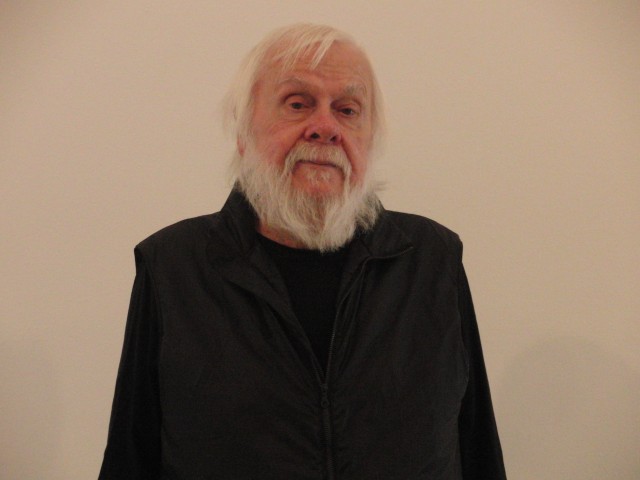
John Baldessari combines art-historical imagery with song titles in latest exhibition (photo by twi-ny/mdr)
twi-ny: Getting back to “Double Play,” the range of works include Gauguin, Bacon, Dix, and primarily Courbet and Eilshemius. Were you looking specifically for images, or were there particular artists you had in mind?
John Baldessari: About two years ago, I decided I was going to start mining imagery from the history of art rather than from newspapers and magazines and TV, whatever, but going about it the same way. I wouldn’t try to get a good image of the work. I wanted it from the media. And then I’d have a huge library, and so I just started plowing through books, collections, individual artists, on and on and on. What I would be looking for would be something in an artist’s work that would be, in a way, inconsequential. There’s always a hierarchy of things in an artist’s work. If it’s a person, obviously you’re going to look at the person’s face, then you might look at what he has on or how he or she is standing. So I looked for something that seems to be the least interesting — oh, like this; that’s not very interesting, you know, that kind of thing — and then I would map out and isolate part of the image and say to an assistant, “Print all these out” so I could look at them and I would sort through those. I guess what I’d be looking for were things that would be visually interesting — to me, anyway, in a formalistic sense, not just in terms of subject matter — and then hopefully it will be interesting to somebody else, who knows. And then I start going through lists and lists of song titles, and then I play marriage broker in trying to get the two of them together somehow and in some way that provided some tension. You know, not an easy association, as I said, but something that was a little bit more difficult because I think one of the things I like to do is make things difficult for people, not in a burdensome way, but I think I got that idea once from reading Kierkegaard and he said, “My job in life is to make life difficult for people.”
twi-ny: To further the challenge, you don’t always take the most obvious part of the image.
John Baldessari: It’s a bit of an art history test. Yeah, some things are pretty obscure, so I made it difficult in that sense. But I think I’ve got a pretty good sense of the viewer, or the spectator, in having taught so long to support myself. So I couldn’t be so obtuse that I would lose people, you know, the students, or be so simplistic that I would lose the smart people. So I think I know how to be a little seductive but have enough there for the most intelligent person but not lose the average person. And of course, for me a model would be, like, Giotto or Matisse, where it looks deceptively simple but it’s not at all.
twi-ny: You mentioned your teaching. Some of your students have gone on to become famous artists themselves, people like Tony Oursler, who also has such an element of fun in his work.
John Baldessari: Absolutely. David Salle, another one, Matt Mullican, and on and on and on. Mike Kelley.
twi-ny: When you had them as students, could you tell which ones would potentially be successful, not necessarily financially but at least creatively?
John Baldessari: I had one sort of idea and I don’t even know if it’s true but I’ll share it with you. There’s always a kid in school that’s really smart, but I think because of that they’ve worked less hard, and the ones that are sort of a little bit way down, they work harder. Those are the students that seem to become successful.
twi-ny: One of the pieces you mentioned before, “Feelings,” is part of the Artists for Obama Portfolio, which also includes works by Frank Gehry, David Hammons, Jasper Johns, and many more. Why did you choose that piece for the project?
John Baldessari: I didn’t do it in any political way. I just thought, who doesn’t love dogs?
twi-ny: Finally, over the last several years, and in the video with Jason Schwartzman, you use cheese as a metaphor for appreciating art. What is your ideal cheese?
John Baldessari: You know, I think I said gorgonzola cheese because my father was Italian and that was the only cheese he would eat. And then I remember some perceptual psychologist writing about art and talking about tastes in art changing. I wish I had said it but I think it’s very apt. He said, when you start out, if you eat cheese at all, it might be Kraft cheese or whatever, and then you get tired of that and you sort of escalate and then you get to the point where smelly cheeses are all you can tolerate. And I thought that was a pretty good description of how taste changes.
THE LONELIEST PLANET
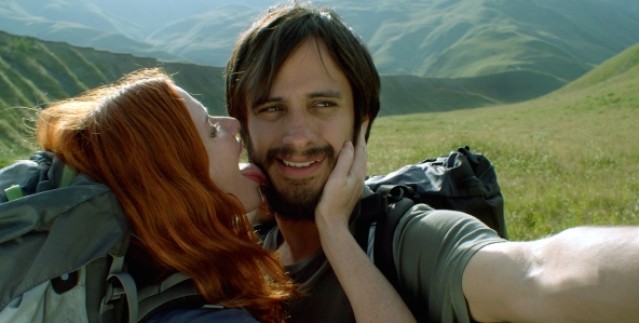
Nica (Hani Furstenberg) and Alex (Gael García Bernal) experience a moment that changes everything in THE LONELIEST PLANET
THE LONELIEST PLANET (Julia Loktev, 2011)
IFC Center
323 Sixth Ave. at West Third St.
Opens Friday, October 26
212-924-7771
www.ifcfilms.com
www.ifccenter.com
 The first half of Julia Loktev’s second feature film, The Loneliest Planet, is a dazzling tour de force, as young lovers Alex (Gael García Bernal) and Nica (Hani Furstenberg) revel in all that life has to offer. Shortly before getting married, they have decided to go on a hiking trip through the Caucasus Mountains in Georgia, led by a guide named Dato (real-life mountaineer Bidzina Gudjabidze, in his first acting role). Alex and Nica are fresh and alive, their eyes filled with wonder, their faces in perpetual, infectious smiles as they make their way through spectacular landscapes gorgeously photographed by cinematographer Inti Briones. In several shots, the three hikers are barely visible walking in the distance as Briones focuses on breathtaking views of the lush green mountainside and vast Central Asian landscape (as well as, in close-up, Furstenburg’s dazzling red hair). What little dialogue there is doesn’t really matter; in fact, much of it is hard to hear, more like background noise, and what is spoken in foreign languages isn’t even translated. But when the travelers run into three locals, something happens that upends the dynamic and severely changes the relationship among Alex, Nica, and Dato, something that requires the kind of split-second decision that one can never take back, resulting in a return journey that is much darker, the smiles, laughter, and romance disappearing in a stark moment. Based on Tom Bissell’s short story “Expensive Trips Nowhere,” The Loneliest Planet recalls such seminal works as Mikhail Kalatozov’s The Letter Never Sent, Andrei Tarkovsky’s Stalker, John Boorman’s Deliverance, Akira Kurosawa’s Dersu Uzala, and Roberto Rosselini’s Voyage in Italy, in which location serves as a character of mystery and potential danger. Loktev, a visual artist who previously made the 1998 documentary Moment of Impact, which details her family’s very personal experiences after her father was hit by a car, and her 2006 narrative debut, Day Night Day Night, about a female Palestinian suicide bomber, has crafted a mesmerizing tale built around small subtleties and the tender, fragile nature of human relationships, in which one misstep can have shattering consequences. Mexican actor García Bernal and New York-born Israeli star Furstenberg make a terrifically believable couple, so vibrant in the first half, so tentative and subdued in the latter sections.
The first half of Julia Loktev’s second feature film, The Loneliest Planet, is a dazzling tour de force, as young lovers Alex (Gael García Bernal) and Nica (Hani Furstenberg) revel in all that life has to offer. Shortly before getting married, they have decided to go on a hiking trip through the Caucasus Mountains in Georgia, led by a guide named Dato (real-life mountaineer Bidzina Gudjabidze, in his first acting role). Alex and Nica are fresh and alive, their eyes filled with wonder, their faces in perpetual, infectious smiles as they make their way through spectacular landscapes gorgeously photographed by cinematographer Inti Briones. In several shots, the three hikers are barely visible walking in the distance as Briones focuses on breathtaking views of the lush green mountainside and vast Central Asian landscape (as well as, in close-up, Furstenburg’s dazzling red hair). What little dialogue there is doesn’t really matter; in fact, much of it is hard to hear, more like background noise, and what is spoken in foreign languages isn’t even translated. But when the travelers run into three locals, something happens that upends the dynamic and severely changes the relationship among Alex, Nica, and Dato, something that requires the kind of split-second decision that one can never take back, resulting in a return journey that is much darker, the smiles, laughter, and romance disappearing in a stark moment. Based on Tom Bissell’s short story “Expensive Trips Nowhere,” The Loneliest Planet recalls such seminal works as Mikhail Kalatozov’s The Letter Never Sent, Andrei Tarkovsky’s Stalker, John Boorman’s Deliverance, Akira Kurosawa’s Dersu Uzala, and Roberto Rosselini’s Voyage in Italy, in which location serves as a character of mystery and potential danger. Loktev, a visual artist who previously made the 1998 documentary Moment of Impact, which details her family’s very personal experiences after her father was hit by a car, and her 2006 narrative debut, Day Night Day Night, about a female Palestinian suicide bomber, has crafted a mesmerizing tale built around small subtleties and the tender, fragile nature of human relationships, in which one misstep can have shattering consequences. Mexican actor García Bernal and New York-born Israeli star Furstenberg make a terrifically believable couple, so vibrant in the first half, so tentative and subdued in the latter sections.
IFC SNEAKS: SOMETHING IN THE AIR
SOMETHING IN THE AIR (APRÈS MAI) (Olivier Assayas, 2012)
BAMcinématek, BAM Rose Cinemas
30 Lafayette Ave. between Ashland Pl. & St. Felix St.
Saturday, October 27, 6:00
Series runs October 26-28
718-636-4100
www.bam.org
www.ifcfilms.com
 Olivier Assayas’s autobiographical coming-of-age tale Something in the Air is a fresh, exhilarating look back at a critical period in twentieth-century French history. In this sort-of follow-up to his 1994 film about 1970s teenagers, Cold Water, which starred Virginie Ledoyen as Christine and Cyprien Fouquet as Gilles, Something in the Air features newcomer Clément Métayer as a boy named Gilles and Lola Créton (Goodbye First Love) as a girl named Christine, a pair of high school students who are part of a growing underground anarchist movement. Following a planned demonstration that is violently broken up by a special brigade police force, some of the students cover their school in spray paint and political posters, leading to a confrontation with security guards that results in the arrest of the innocent Jean-Pierre (Hugo Conzelmann), which only further emboldens the anarchists. But their seething rage slowly changes as they explore the transformative world of free love, drugs, art, music, travel, and experimental film. Assayas (Les Destinées sentimentales, Summer Hours) doesn’t turn Something in the Air — the original French title is actually Après Mai, or After May, referring to the May 1968 riots — into a personal nostalgia trip. Instead it’s an engaging and charming examination of a time when young people truly cared about something other than themselves and genuinely believed they could change the world, filled with what Assayas described as a “crazy utopian hope for the future” at a New York Film Festival press conference. The talented cast also includes Félix Armand, India Salvor Menuez, Léa Rougeron, and Carole Combes as Laure, both Gilles’s and Assayas’s muse.
Olivier Assayas’s autobiographical coming-of-age tale Something in the Air is a fresh, exhilarating look back at a critical period in twentieth-century French history. In this sort-of follow-up to his 1994 film about 1970s teenagers, Cold Water, which starred Virginie Ledoyen as Christine and Cyprien Fouquet as Gilles, Something in the Air features newcomer Clément Métayer as a boy named Gilles and Lola Créton (Goodbye First Love) as a girl named Christine, a pair of high school students who are part of a growing underground anarchist movement. Following a planned demonstration that is violently broken up by a special brigade police force, some of the students cover their school in spray paint and political posters, leading to a confrontation with security guards that results in the arrest of the innocent Jean-Pierre (Hugo Conzelmann), which only further emboldens the anarchists. But their seething rage slowly changes as they explore the transformative world of free love, drugs, art, music, travel, and experimental film. Assayas (Les Destinées sentimentales, Summer Hours) doesn’t turn Something in the Air — the original French title is actually Après Mai, or After May, referring to the May 1968 riots — into a personal nostalgia trip. Instead it’s an engaging and charming examination of a time when young people truly cared about something other than themselves and genuinely believed they could change the world, filled with what Assayas described as a “crazy utopian hope for the future” at a New York Film Festival press conference. The talented cast also includes Félix Armand, India Salvor Menuez, Léa Rougeron, and Carole Combes as Laure, both Gilles’s and Assayas’s muse.
Assayas fills Something in the Air with direct and indirect references to such writers, artists, philosophers, and musicians as Syd Barrett, Gregory Corso, Amazing Blondel, Blaise Pascal, Kasimir Malevitch, Max Stirner, Alighiero Boetti, Joe Hill, Soft Machine, Georges Simenon, Frans Hals, and Simon Ley (The Chairman’s New Clothes: Mao and the Cultural Revolution), not necessarily your usual batch of 1970s heroes who show up in hippie-era films. Writer-director Assayas, editors Luc Barnier and Mathilde Van de Moortel, and cinematographer Éric Gautier move effortlessly from France to Italy to England, from thrilling, fast-paced chases to intimate scenes of young love to a groovy psychedelic concert, wonderfully capturing a moment in time that is too often marginally idealized and made overly sentimental on celluloid. “We’ve got to get together sooner or later / Because the revolution’s here,” Thunderclap Newman sings in their 1969 hit “Something in the Air,” which oddly is not used in Assayas’s film, continuing, “And you know it’s right / and you know that it’s right.” Indeed, Assayas gets it right in Something in the Air, depicting a generation when revolution required a lot more than clicking a button on the internet. Something in the Air is screening October 27 at 6:00 as part of the BAMcinématek series “IFC Sneaks” and will be followed by a Q&A with Menuez. The series, which runs October 26-28, offers an advance look at such upcoming IFC Films as Rodney Ascher’s Room 237, an obsessive examination of Stanley Kubrick’s The Shining, and Walter Salles’s hotly anticipated On the Road, an adaptation of the Jack Kerouac novel with Garrett Hedlund as Dean Moriarty, Sam Riley as Sal Paradise, Kristen Stewart as Marylou, Amy Adams as Jane, Kirsten Dunst as Camille, and Viggo Mortensen as Old Bull Lee.
HAPPINESS IS . . . THE 400 BLOWS
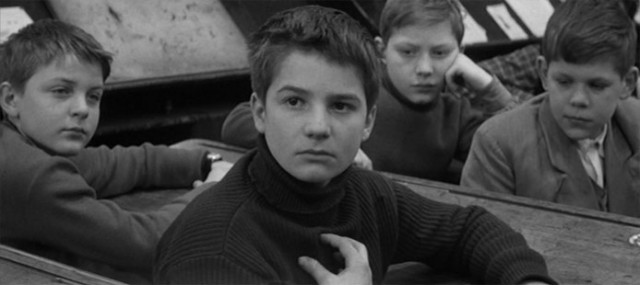
Antoine Doinel (Jean-Pierre Léaud) can’t seem to stay away from trouble in François Truffaut’s THE 400 BLOWS
CABARET CINEMA: THE 400 BLOWS (LES QUATRE CENTS COUPS) (François Truffaut, 1959)
Rubin Museum of Art
150 West 17th St. at Seventh Ave.
Friday, October 26, free with $7 bar minimum, 9:30
212-620-5000
www.rmanyc.org
 “They won’t be happy you’re missing school like this,” a man tells fourteen-year-old Jean-Pierre Léaud as he’s auditioning for the part of Antoine Doinel in François Truffaut’s The 400 Blows. “It doesn’t matter, as long as I’m happy,” Léaud responds. Screening on October 26 as part of the Rubin Museum Cabaret Cinema series “Happiness Is . . . ,” where it will be introduced by Columbia professor and Truffaut expert Annette Insdorf, The 400 Blows marked the first of five films, including one short, in which Léaud played the iconic character, as audiences around the world followed his search for happiness. In The 400 Blows, Doinel is a twelve-year-old kid who loves Balzac, has never seen the ocean, and is always getting into trouble with his parents, who treat him more like a problem than a son. He is clearly very smart, but he does poorly in school, where he is harassed by his teacher (Guy Decomble). One day when he decides to play hooky, he catches his mother (Claire Maurier) kissing another man, and instead of telling his father (Albert Rémy), he runs away from home, moving in with his friend René (Patrick Auffay), setting off a series of events that lead to a whole lot more trouble and an unforgettable final shot. The 400 Blows is one of the most intelligent films ever made about adolescence, a tender, honest portrayal of a mischievous kid who just wants to be understood. Léaud gives a wonderfully nuanced performance that makes Antoine a uniquely believable and sympathetic character even when he is making some very bad choices. The film is also about escape of all kinds, beginning and ending with the camera racing away alongside Jean Constantin’s glorious score. The Adventures of Antoine Doinel series continues with 1962’s Antoine and Colette, 1968’s Stolen Kisses, 1970’s Bed and Board, and 1979’s Love on the Run, while “Happiness is . . .” continues through December 28 with such films as Ingmar Bergman’s Cries and Whispers, Michael Curtiz’s Casablanca, and George Cukor’s Camille, held in conjunction with the larger Rubin Museum program “Happy Talk.”
“They won’t be happy you’re missing school like this,” a man tells fourteen-year-old Jean-Pierre Léaud as he’s auditioning for the part of Antoine Doinel in François Truffaut’s The 400 Blows. “It doesn’t matter, as long as I’m happy,” Léaud responds. Screening on October 26 as part of the Rubin Museum Cabaret Cinema series “Happiness Is . . . ,” where it will be introduced by Columbia professor and Truffaut expert Annette Insdorf, The 400 Blows marked the first of five films, including one short, in which Léaud played the iconic character, as audiences around the world followed his search for happiness. In The 400 Blows, Doinel is a twelve-year-old kid who loves Balzac, has never seen the ocean, and is always getting into trouble with his parents, who treat him more like a problem than a son. He is clearly very smart, but he does poorly in school, where he is harassed by his teacher (Guy Decomble). One day when he decides to play hooky, he catches his mother (Claire Maurier) kissing another man, and instead of telling his father (Albert Rémy), he runs away from home, moving in with his friend René (Patrick Auffay), setting off a series of events that lead to a whole lot more trouble and an unforgettable final shot. The 400 Blows is one of the most intelligent films ever made about adolescence, a tender, honest portrayal of a mischievous kid who just wants to be understood. Léaud gives a wonderfully nuanced performance that makes Antoine a uniquely believable and sympathetic character even when he is making some very bad choices. The film is also about escape of all kinds, beginning and ending with the camera racing away alongside Jean Constantin’s glorious score. The Adventures of Antoine Doinel series continues with 1962’s Antoine and Colette, 1968’s Stolen Kisses, 1970’s Bed and Board, and 1979’s Love on the Run, while “Happiness is . . .” continues through December 28 with such films as Ingmar Bergman’s Cries and Whispers, Michael Curtiz’s Casablanca, and George Cukor’s Camille, held in conjunction with the larger Rubin Museum program “Happy Talk.”
JUSTIN TOWNES EARLE: IN THE SPIRIT OF WOODY GUTHRIE

Justin Townes Earle will lead Woody Guthrie centennial tribute at Pace on October 26-27 (photo by twi-ny/mdr)
PACE PRESENTS
Pace University, Michael Schimmel Center for the Arts
3 Spruce St.
October 26-27, $25-$50, 7:30
www.pace.edu
www.justintownesearle.com
Since his 2008 debut record, The Good Life, Nashville-born singer-songwriter Justin Townes Earle has been wearing his heavy heart — and his diverse influences — on his long sleeves. Melding his own American roots-rock blend of folk, rock, jazz, pop, and blues, Earle doesn’t hide that he is the son of Steve Earle and was named for his father’s mentor, Townes Van Zandt. “I hear my father on the radio / Singin’ ‘Take Me Home Again’ / Three hundred miles from the Carolina coast and I’m / I’m skin and bones again / Sometimes I wish that I could get away / Sometimes I wish that he’d just call,” Earle sings on “Am I That Lonely Tonight?,” the opening track of his most recent album, Nothing’s Gonna Change the Way You Feel About Me Now (Bloodshot, March 2012). The follow-up to 2010’s Harlem River Blues and 2009’s Midnight at the Movies, the younger Earle’s latest is an exploration of love and loneliness seen through the eyes of a man still searching for his place in the world. “So, please, baby, just drive / Carry me out into the night / Carry me out into the night / ’Cause I need to know / That there’s something more to this life / That there’s something more to this moment,” he pleads on “Passin’ Through Memphis in the Rain.” Among Earle’s other influences are Bruce Springsteen, Kris Kristofferson, Randy Newman, and Woody Guthrie. On October 26 & 27, Earle will be at Pace’s Michael Schimmel Center honoring that last influence for the special program “In the Spirit of Woody Guthrie,” being held in conjunction with the centennial of Woodrow Wilson Guthrie’s birth. Earle will host two nights of music and stories featuring original songs and covers, with Earle and his specially chosen guests, which include Deer Tick’s John McCauley, the Low Anthem, Joe Pug, and bestselling author and columnist Joe Klein.
